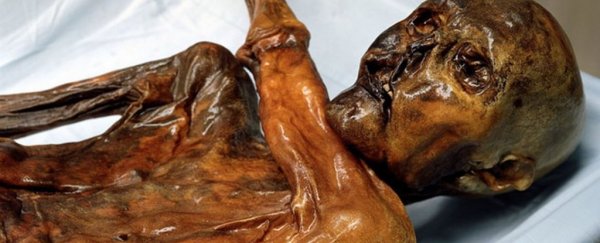We already know what Ötzi the Iceman was wearing when he died more than 5,000 years ago in the Italian Alps, as well as how many tattoos he had.
But now scientists have taken things one step further: they've managed to recreate the "best possible approximation" of his voice.
By using CT scans to measure the structure of the famous mummy's vocal cords, throat, and mouth, scientists from Bolzano's General Hospital in Italy have been able to digitally reconstruct what Ötzi might have sounded like while pronouncing vowels in Italian.
Based on their data, Ötzi most likely spoke in a deep, and slightly creepy, voice - as you can hear below:

"We can't say we have reconstructed Ötzi's original voice, because we miss some crucial information from the mummy," lead researcher Rolando Füstös told Rossella Lorenzi from Discovery News.
"But with two measurements, the length of both the vocal tract and the vocal cords, we have been able to recreate a fairly reliable approximation of the mummy's voice. This is a starting point for further research."
The vocalisations were presented this week at a meeting to celebrate 25 years since the discovery of Ötzi at the European Research Academy (EURAC) Institute for Mummies and the Iceman in Bolzano.
Ötzi was found by two German hikers in 1991, frozen and mummified in the Ötzal Alps in South Tyrol, and is Europe's oldest known natural mummy, providing researchers with an unprecedented glimpse into what life was like around 3,300 BC, during the Chalcolithic, or copper, age.
Scientists have since discovered that Ötzi was murdered - he most likely died from an arrow wound to his shoulder - and that he was dressed in a mix of sheep, goat, and cow skin when he was killed. He also sported a deerskin quiver and a bearskin cap (baller, right?).
His 61 tattoos have also been studied in detail, and by reconstructing his voice, researchers hope to gain more insight into what humans might have sounded like back then.
"Of course, we don't know what language he spoke 5,000 years ago," one of the researchers, Francesco Avanzini, told CNN earlier this year. "But we should be able to recreate the timbre of his vowel sounds and, I hope, even create simulation of consonants."
They've now succeeded with the vowel reconstruction - although it was more challenging than they first imagined.
For starters, they could only use CT scans to map Ötzi's internal structure - MRI scans would have given them more information, but could have damaged the mummy.
And then there's the way that Ötzi died.
"We had to deal with Ötzi's position, whose arm is covering his throat," Avanzini told Discovery News. "For our project this is the worst position you can imagine. Moreover, the hyoid bone - or tongue-bone - was party absorbed and dislocated."
Using software, the team was able to digitally move Ötzi's arm in the scans, and reposition his skull, allowing them to recreate the full physical structure of the vocal tract.
The information they didn't have - the tension and density of the vocal cords, and the thickness and composition of the throat tissue - they reconstructed using mathematical models, and software that stimulates how the vocal tract works.
With all that information, the team predicts that Ötzi's voice had a frequency between 100 and 150 Hz, which is similar to average males today.
The research hasn't been published in a peer-reviewed journal as yet, and there's no word on when the team is planning to do that - they might be hoping to recreate some more complex vocalisations first.
Until then, we need to take the 'voice' you hear above with a grain of salt, because it's only one team's interpretation of what the Iceman would have sounded like. But the fact that we now have some idea of what a human might have sounded like 5,000 years ago is pretty exciting.
We might never know what Ötzi had to say, or the circumstances surrounding his murder, but it's nice to know that we can still (sort of) hear him speak.
